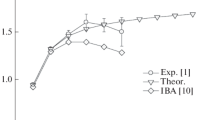Abstract
The ammonium ion in the alkali halide lattice has the hindered rotational state. The rotational potential is expressed as crystal field, which depends upon only one rotational motion. The tetrahedral ion receives an octahedral field in this system. Four fundamental types of orientation appear due to the symmetry of ion and that of field. As the barrier height increases, the rotational levels approach to the librational levels with tunnel splitting. In particular, the tunneling part in the ground librational level is calculated using both free rotor bases and orientationally localized states. The level structure with the degeneracy is elucidated, which is peculiar in each type of orientation. Thermal properties are shown as model calculations.
Similar content being viewed by others
References
A. Inaba, H. Chihara, J. A. Morrison, H. Blank, A. Heidemann and J. Tomkinson, J. Phys. Soc. Jpn., 59 (1990) 522.
Y. Ozaki, J. Phys. Soc. Jpn., 56 (1987) 1017.
R. Mukhopadhyay, B. A. Dasannacharya, J. Tomkinson, C. J. Carlile and J. Gilchrist, J. Chem. Soc. Faraday Trans., 90 (1994) 1149.
Author information
Authors and Affiliations
Rights and permissions
About this article
Cite this article
Ozaki, Y. Rotational states of the ammonium ion in cubic lattice. Journal of Thermal Analysis and Calorimetry 69, 979–983 (2002). https://doi.org/10.1023/A:1020688813348
Issue Date:
DOI: https://doi.org/10.1023/A:1020688813348




